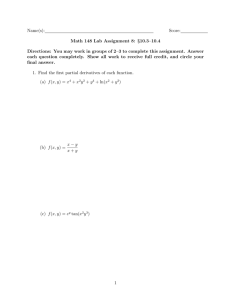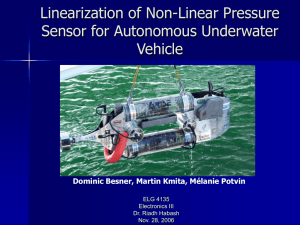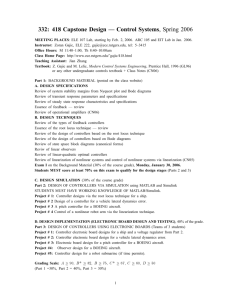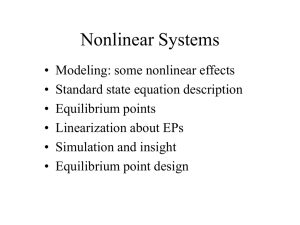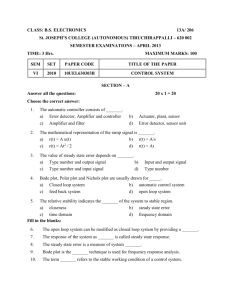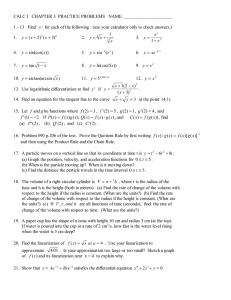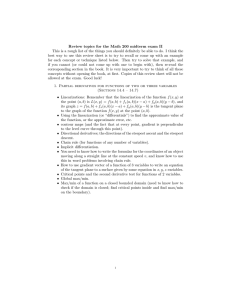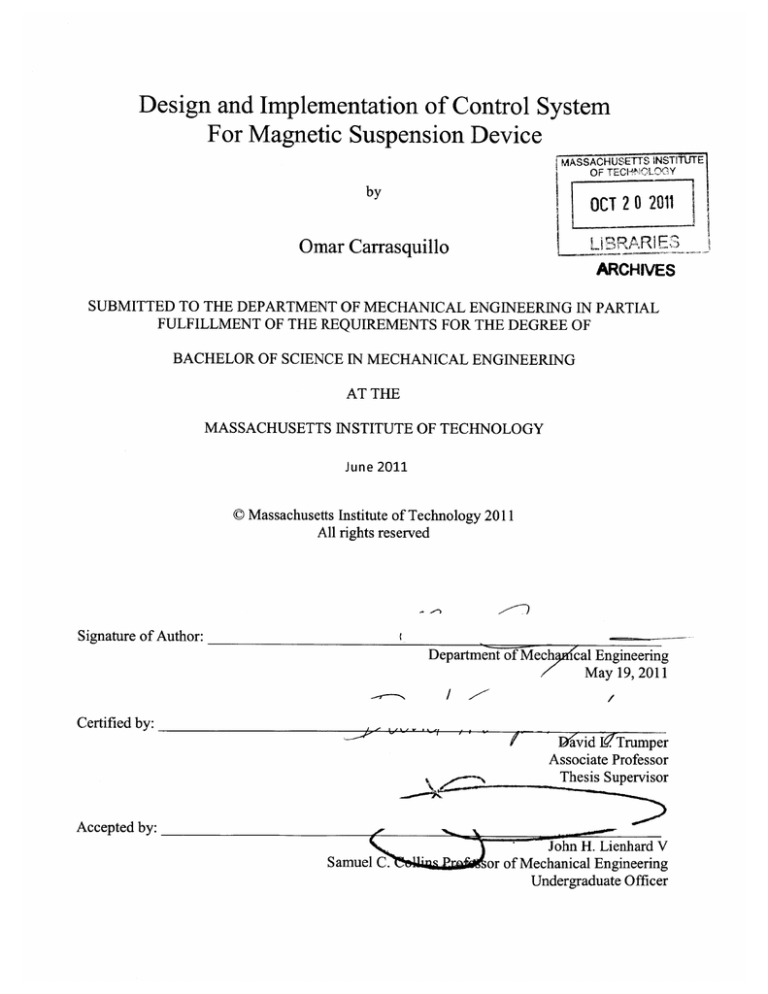
Design and Implementation of Control System
For Magnetic Suspension Device
MASSACHUSETTS INSTITUTE
OF TECINOLOGY
by
OCT20 2011
Omar Carrasquillo
ARCHIVES
SUBMITTED TO THE DEPARTMENT OF MECHANICAL ENGINEERING IN PARTIAL
FULFILLMENT OF THE REQUIREMENTS FOR THE DEGREE OF
BACHELOR OF SCIENCE IN MECHANICAL ENGINEERING
AT THE
MASSACHUSETTS INSTITUTE OF TECHNOLOGY
June 2011
0 Massachusetts Institute of Technology 2011
All rights reserved
Signature of Author:
Department of Mech
al Engineering
May 19, 2011
Certified by:
Dravid ITrumper
Associate Professor
Thesis Supervisor
Accepted by:
Samuel C.
John H. Lienhard V
or of Mechanical Engineering
Undergraduate Officer
2
Design and Implementation of Control System
For Magnetic Suspension Device
by
Omar Carrasquillo
Submitted to the Department of Mechanical Engineering
on May 6, 2011 in Partial Fulfillment of the
Requirements for the Degree of Bachelor of Science in
Mechanical Engineering
ABSTRACT
The purpose of this thesis was to gain more knowledge and experience in the areas of modeling,
dynamics, and applied control theory. A single-axis magnetic suspension device originally
designed by Professor David Trumper for classroom demonstrations was chosen to improve the
understanding of the previously mentioned topics. The dynamics of these types of systems
provide interesting control challenges due to the nonlinear nature of its dynamics. As a result,
designing of a control system for this device required the understanding and experimentation of
two nonlinear controls techniques: linearization of the plant around an operating point, and
feedback linearization. A combination of electromagnetic theory and experimentation was used
to model the suspension actuator, and two different controllers were designed and implemented
using the different controls methods.
Thesis Supervisor: David L. Trumper
Title: Associate Professor
4
ACKNOWLEDGEMENTS
I would like to thank my thesis supervisor and academic advisor Professor David L.
Trumper for his guidance and support during my time at MIT. This past year has been
particularly challenging due to coursework, thesis research, and graduate school decisions, and
Professor Trumper has been a great advisor along the way. In particularly, I would like to thank
him for pointing me in the right direction during the period of time I've been working on this
thesis to make sure I would complete the goal. I would also like to thank Mohammad Imani
Nejad, Dr. Harrison Chin, and Roberto Melendez for answering my questions regarding
magnetic levitation and basic control theory.
In my personal life, I would like to thank my family, specially my parents, Diego and
Vanessa, for their unconditional love and support throughout my life. Also, I would like to thank
the Theta Deuteron Charge of Theta Delta Chi for being a constant source of support I know I
can rely on. Additionally, I would like to thank Nancy Foen, Charlie De Vivero, Michael Munoz,
Parhys Napier, Michael Fraser, Pablo Bello, and Javier Garcia for their incredible support and
their help dealing with difficult situations.
6
TABLE OF CONTENTS
LIST OF FIGURES .............................................................................................................................
9
Chapter 1: Introduction.................................................................................................................
13
1.1
System Overview ........................................................................................................
13
1.2
Background ....................................................................................................................
16
1.2.1
Linearized M odel..................................................................................................
16
1.2.2
Feedback Linearization........................................................................................
17
Chapter 2: Control Loop System ...............................................................................................
18
2.1
Introduction ....................................................................................................................
18
2.2
Light Sensor ...................................................................................................................
19
2.3
Actuator Coil..................................................................................................................
20
2.3.1
Source of Data....................................................................................................
20
2.3.2
Actuator M odel....................................................................................................
21
Chapter 3: N onlinear Control Techniques .................................................................................
3.1
24
Linearization...................................................................................................................
24
3.1.1
System Dynam ics................................................................................................
24
3.1.2
Controller
27
3.1.3
Controller Implem entation..................................................................................
36
Feedback Linearization ...............................................................................................
40
3.2
3.2.1
................................................................................................
Theory .....................................................................................................................
7
40
3.2.2
Controller Design...............................................................................................
41
3.2.3
Controller Implementation..................................................................................
48
Levitating Steel Ball....................................................................................................
55
3.3
Chapter 4: Conclusion...................................................................................................................
56
BIBLIOGRAPHY .............................................................................................
57
LIST OF FIGURES
Figure 1: Conceptual schematic of magnetic suspension device. .............................
14
Figure 2: Photograph of physical hardware of magnetic suspension device ................. 14
Figure 3: Photograph of the micrometer fixture. (Taken from [2])..............................16
Figure 4: Block diagram of system with controller based on feedback linearization. (Taken
from [2])....................................................................................
17
Figure 5: System control loop diagram. (Taken from [2]) .....................................
19
Figure 6: Plot of air gap vs. load sensor readings used to calibrate the position sensor. Data
interpolated with cubic fit. .............................................................
20
Figure 7: Measured and modeled force-current relationships at 7mm gap.
(Taken from [5]).............................................................................23
Figure 8: Free-body diagram of steel ball under suspension .....................................
24
Figure 9: Bode plot for linearized plant transfer function (Equation 14) .................... 27
Figure 10: Simulated Bode plot for loop transmission of linearized system with model given
by Equation 15 with K=27, a=10, and r=0.005. ....................................
29
Figure 11: Simulated closed loop step response of linearized system with lead compensation
in the forward path; model given by Equation 15 with K=27, a=10, and
T= 0.005 ................................................................................
. . 30
Figure 12: Simulated Bode plot for loop transmission of linearized system with model given
by Equation 15 with K = 92, a=10, and c=0.0023. .................................
31
Figure 13: Simulated closed loop step response of linearized system with lead compensation
in the forward path; model given by Equation 15 with K=92, a= 10, and
T= 0 .002 3 ......................................................................................
32
Figure 14: Simulated Bode plot for loop transmission of linearized system with lead and lag
compensation in the forward path......................................................33
Figure 15: Simulated closed loop step response of linearized system with lead and lag
compensation in the forward path ....................................................
34
Figure 16: Simulated closed loop step response of linearized system with lead compensation
in feedback path and lag compensation in the forward path .......................
35
Figure 17: Simulink block diagram used to implement the linear controller for the linearized
system around an operating point, xbar...............................................36
Figure 18: Position response as calculated form position sensor voltage measurement to a
0.5 mm step at 8 mm air gap (Linearized).............................................37
Figure 19: Position response as calculated form position sensor voltage measurement to a
0.5 mm step at 7 mm and 6 mm air gap (Linearized)...............................38
Figure 20: Position response as calculated form position sensor voltage measurement to a
0.5 mm step at 9 mm and 10 mm air gap (Linearized)...............................39
Figure 21: Simulated Bode plot for plant transfer function with feedback linearization based
on Equation 20. ..........................................................................
42
Figure 22: Simulated Bode plot for loop transmission of feedback linearized system with
lead compensation; model given by Equation 15 with K=83, a=10, and
r= 0 .00 5 .....................................................................................
43
Figure 23: Simulated closed loop step response of feedback linearized system with lead
compensation in the forward path; model given by Equation 15 with K=83, a=10,
and t = 0.005. ...............................................................................
44
Figure 24: Root locus plot of suspension system with lead compensation...................45
Figure 25: Simulated closed loop step response of feedback linearized system with lead
compensation in the feedback path; model given by Equation 15 with K=83, a=10,
and T=0.005. .................................................................................
46
Figure 26: Simulated Bode plot for loop transmission of feedback linearized system with
lead compensation in feedback path and lag compensation in forward path ....... 47
Figure 27: Simulated closed loop step response of feedback linearized system with lead
compensation in feedback path and lag compensation in forward path. ............ 47
Figure 28: Simulink block diagram used to implement the controller of feedback linearized
system ....................................................................................
. . 48
Figure 29: Position response as calculated from position sensor voltage measurement to a
0.5 mm step at 5 mm air gap (Feedback Linearization).............................49
Figure 30: Position response as calculated from position sensor voltage measurement to a
0.5 mm step at 6 mm and 7 mm air gap (Feedback Linearization)..................50
Figure 31: Position response as calculated from position sensor voltage measurement to a
0.5 mm step at 8 mm and 9 mm air gap (Feedback Linearization)..................51
Figure 32: Position response as calculated from position sensor voltage measurement to a
0.5 mm step at 10 mm and 11 mm air gap (Feedback Linearization) ............
52
Figure 33: Position response as calculated from position sensor voltage measurement to a
0.5 mm step at 12 mm and 13 mm air gap (Feedback Linearization).............53
Figure 34: Position response as calculated from position sensor voltage measurement to a
0.5 mm step at 14 mm and 15 mm air gap (Feedback Linearization).............54
Figure 35: Photograph of steel ball in suspension ..............................................
55
12
Chapter 1: Introduction
The objective of this thesis was to improve my knowledge in feedback control systems by
designing and implementing a controller for a naturally unstable system. For this purpose, a onedegree-of-freedom magnetic suspension system was chosen; the complexities due to the
nonlinear force/current/gap relationship provide an interesting challenge from a control theory
perspective. Many undergraduate control theory classes focus mostly on linear controllers, so
when studying nonlinear systems one is taught the method of linearizing around operating points
in order to use the linear control techniques. However, this approach is not optimal for this
system because many applications of magnetic suspension require that the system can operate
over large variations of air gap. Thus, we explored the use on feedback linearization, a type of
nonlinear control technique, as an alternate way to control systems with large variations around
operating points.
1.1
System Overview
The single degree of freedom magnetic suspension device studied in this thesis is
described in great detail in [1] and [2]. It was originally constructed and developed by Professor
David Trumper with his students at the University of North Carolina at Charlotte to be used as a
classroom demonstration illustrating nonlinear control. The levitation system, consisting of a
position sensor, a magnetic actuator and a controller, is shown in Figure 1 as a conceptual
schematic. Figure 2 shows an actual photograph of the hardware.
Actuator
Light
Detector
C
(
Light
Source
+- (
Controller
Figure 1: Conceptual schematic of magnetic suspension device.
Figure 2: Photograph of physical hardware of magnetic suspension device
In this system, a steel ball of mass m = 0.067kg is suspended below a 2200-turn solenoid
wound on a one inch steel core. This solenoid is an electromagnet whose field strength depends
on the amount of current flowing through the coils at a given time, meaning that the
electromagnet's magnetic force can be controlled by adjusting the current. This magnetic force
can counteract the effect of gravity on the ball at a point of equilibrium. Hence, the vertical
position of the ball can be actively controlled by manipulating the current flowing through the
solenoid.
The other important part of the suspension system is the mechanism to detect the position
of the ball. In this case, an optical sensor is used consisting of a light source and a photo detector.
As the air gap between the ball and the pole of the electromagnet changes, so does the amount of
light detected by the sensor. The controller correlates the amount of light detected by the sensor
to the position of the ball and compares it to a reference input position, adjusting the magnetic
force on the ball as needed by manipulating the current flow through the electromagnet. To
calibrate the position sensor as well as characterize the nonlinear relationship between force,
current, and air gap, a micrometer fixture, depicted in Figure 3 which was taken from [2], was
used. Having these nonlinear equations, controllers were designed using two different
approaches. One method involved linearizing the nonlinear equations about an operating point.
The second approach used feedback linearization, which eliminates the operating point
dependency and allows suspension over a wide range of air gaps. Both controllers were
implemented and the systems response to step inputs were measured for both settings.
Figure 3: Photograph of the micrometer fixture. (Taken from [2])
1.2
Background
1.2.1 Linearized Model
In magnetic suspension systems, the nonlinearity emerges from the relationship between
force, current, and air gap. In one approach, when nonlinear components are present, the system
can be linearized about an operating point to yield a transfer function. As explained in [4], when
a nonlinear equation is linearized, it is done so "for small-signal inputs about the steady-state
solution when the small-signal input is equal to zero." This means that linearization of a system
is limited to the region around the operating points, or points of equilibrium. After finding the
equilibrium points, a Taylor series expansion is used to approximate the behavior of the system
for a small range around these operating points.
1.2.2
Feedback Linearization
Feedback linearization is a technique that transforms a nonlinear system into a linear and
controllable one. As described in [3], in the magnetic suspension application studied for this
thesis, the complete nonlinear description of the electromagnetic field can be transformed into an
apparent linear system. Hence, we could obtain consistent performance largely independent of
the operating point air gap. After the system has been transformed, it is possible to use
conventional linear feedback techniques to design a controller. Figure 4 shows a conceptual
block diagram of a controller design using feedback linearization.
Figure 4: Block diagram of system with controller based on feedback linearization.
(Taken from [2])
Chapter 2: Control Loop System
2.1
.
Introduction
A schematic representation of the magnetic suspension device was taken from [2] and is
shows in Figure 5. The system consists of a position sensor, linear amplifier, digital controller,
and actuator coil. The position sensor consists of a photodiode array illuminated by an array of
light emitting diodes (LEDs). A steel ball is suspended between the LED light source and the
detector and as its vertical position changes, so does the amount of light that enters the detector.
Thus, the photodiode array produces a current proportional to the position of the steel ball. This
current passes through a transresistance amplifier that converts the photodiode current to a
voltage representative of position which can be fed into the computer. To control the actuator
coil, a linear amplifier receives a voltage signal from the computer and produces a proportional
current to drive the coil; hence, adjusting the magnetic force being applied to the steel ball.
The system is controlled via a desktop computer with a dSPACE board. We are able to
communicate with the hardware using the dSPACE board in conjunction with MATLAB and
Simulink software. Since Simulink supports block diagrams, a model of the compensated system
is built on Simulink and downloaded onto the dSPACE board.
Linear
Amplifier
D/A
ci
16 Element
--
D
Set
OSPACE
Ref
5 Elernent
Controller
Superbright
LED Array
Photodiode
Array
_
Transresistance
Amp ier
Figure 5: System control loop diagram. (Taken from [2])
2.2
Light Sensor
The magnetic suspension system uses a light sensor to determine the position of the
suspended steel ball. The air gap we are trying to control is the distance between the coil and
suspended ball. As the air gap decreases, the ball creates a shadow between the LED light source
and the light sensor which decreases its current output and thus the voltage reading that comes
into the dSPACE board. In order to determine the relationship between gap and voltage, a steel
ball was attached to a micrometer and moved through the gap range while recording the voltage
reading from the transresistance amplifier. The data is plotted in Figure 6. MATLAB was used to
plot the data and find a cubic fit to describe the air gap corresponding to a voltage reading. This
fit was used in the controller implementations in Simulink.
Air gap vs. Light Sensor measurements
18*'*
16-
Data
.-- -- Best-Fit
14x
= -526.28v 3 -375.21v
2-
106.82v + 1.17
12
E 10M8-
6-4
42
0r
-0.4
-0.35
-0.3
r
-0.25
r
r
-0.2
-0.15
r
-0.1
-0.05
r
r
0
0.05
Voltage [V]
Figure 6: Plot of air gap vs. load sensor readings used to calibrate the position
sensor. Data interpolated with a cubic fit.
2.3
Actuator Coil
2.3.1 Source of Data
In order to have a good understanding of the relationship between the current flowing
through the coil, the magnetic force it executes on the steel ball and the air gap, it was necessary
to run a series of tests. In past works, like those explained with great detail in [1], [2] and [5], a
piezo-electric load cell attached to the steel ball in the micrometer structure shown in Figure 3
was used to measure the force applied by the actuator coil, for an applied current, on the steel
ball at a given air gap. Due to time limitations, data from these sources was used in the present
work.
2.3.2 Actuator Model
The equation that describes the force produced by an electromagnet, as taken from [2] is
2
F =C x ,
(1)
where F is the force applied to the ball, i is the current through the coil, and x is the air gap, the
distance between the pole of the electromagnet and the steel ball. The constant C (Nm2/A 2 )
depends on material properties and physical structure and it must be determined experimentally.
In addition, it is important to note that in this model, the gap length is increasing in the
downward direction, meaning that at large values of x, the ball is far from the pole of the
electromagnet.
In [2], Yi Xie provides great details about the nonidealities of the system that are not
taken into account in Equation 1. From these, it is important to highlight that the ideal case
assumes that all the magnetic flux is concentrated in the air gap. Using a magnetic circuit
analogy to this system, Yi Xie explains that the ideal model suggests an infinite force on the ball
with zero air gap space. Taken this into account, a constant factor, xo, is added to the gap length
in the denominator of Equation 1 so that the force approaches a finite value as the air gap
approaches zero. The new equation is
F =C
2
(2)
Both xo and C were found experimentally in [2]. They were reported to be
x0 =0.0025 m,
(3)
and
C =-0.003 x+ 6.54x 10- 4
M
A2
(4)
In [2] and in [5] the force-current-gap data was measured experimentally using the
micrometer fixture with the piezo-electric load cell. As different amounts of current were passed
through the coil, the magnetic force on the steel ball was recorded at different air gaps. Figure 7,
which was taken from [5], shows the force-current relationship measured at 7mm gap as well as
the model described by Equation 2. It can be seen that the model is not accurate after currents of
O.4A. In [2], careful experimentation and trial and error led to a higher order model which
models the force-current relationship more accurately at a particular gap. This higher order
model is shown in Equation 5 and was also included in Figure 7.
O
)2 22. .
=(x + x00)FL
) + F 0.0195e
0.001 - 3x-0.002
3.5(x -0.007)) + 450(x - 0.0014)2F
(5)
coil force vs. coil current at 7mm gap
1.4
t 2
1
0,8
0,4
0,2
4
force [NJ
Figure 7: Measured and modeled force-current relationships at 7mm gap. (Taken
from [5])
Chapter 3: Nonlinear Control Techniques
3.1
Linearization
3.1.1
System Dynamics
The concept behind magnetic suspension is to use the magnetic force created by the
electromagnet to counteract the effect of gravity on the steel ball; hence, when these two forces
are balanced, there is a point of equilibrium. A way to solve this control problem is to linearize
the system around these equilibrium, or operating, points and use traditional linear control
techniques. In order to linearize the system, we have to use a first-order Taylor series expansion
to approximate the behavior of the system over a limited range around the operating points. After
analyzing the free-body diagram of the system, shown in Figure 8, we can find the equilibrium
points by balancing the forces in the vertical direction.
Electromagnet
Fm
X
mg
Figure 8: Free-body diagram of steel ball under suspension.
Sum of forces in the vertical direction yields
mx = mg-F..
(6)
Substituting for the magnetic force, we can rewrite Equation 6 as
m 32= Mg - C( -).(7
Looking at Equation 7, we can see the nonlinear term which depends on current and air
gap. Thus, we need to linearize the system about these two variables by taking a first-order
Taylor series expansion about points that describe a desired operating point and small deviations
from:
_~ -
(8)
x=x+x
In Equation 8, the bar denotes the equilibrium operating point and tilde represents small
deviations from the operating point. Applying a first order approximation of the Taylor series
expansion of the magnetic force gives
F =C1 FI
2
C
WF
~
8aF
x
(9)
ax7
Solving the partial differential equations, we get
--
x i
= - 2C _23xx
(10)
2C
-
2
-
For simplicity, we will assign the following constants:
-2
k =2C _
X(11)
k 2 =2C-h.
x
To find the point of equilibrium or the system, we know the sum of forces in the vertical must
equal zero. This means that at the operating point,
mg=C
2.
(12)
Combining Equations 7-12, we yield the final differential equation representing the linearized
system:
mx=k x -k 2 i
(13)
Now, we can find the transfer function of the system that describes the air gap as a result of the
current input by taking the Laplace transform of the linearized differential equation and
rearranging some terms:
X(s)
-k
I(s)
2
2
(14)
ms -k
Analyzing the transfer function in Equation 14, we can see that the system is open loop
unstable due to a pole in the right hand side of the complex plane. Thus, controller compensation
has to move the unstable pole into the stable left-half plane region.
3.1.2
Controller Design
In order to stabilize our system, we implemented a lead compensator with the form
(15)
Gc(s)=K cts + 1
r-s +1
A lead compensator allows us to add phase to the uncompensated system in the neighborhood of
the crossover frequency. We chose to place the compensator's pole and zero a decade a part,
meaning a = 10. For the controller design, we will choose a crossover frequency of 10 Hz (62.8
rad/s). To determine the parameters of the lead compensator, we will look at the plant's Bode
plot, shown in Figure 9, to see how we need to compensate the system to make it stable.
Bode Diagram
-30
1 6
'.
;
-
j
-40
-50
8
-60
:9 -70
-80
-90
..........
.......
... ...........
-179
............
.--
-179.5
-180
-180.5
-181
10
10
Frequency (rad/sec)
103
Figure 9: Bode plot for linearized plant transfer function (Equation 14).
At the chosen crossover frequency of 62.8 rad/s, the magnitude of the uncompensated plant is
0.0118. In addition, we see that the plant's phase is -180* for all frequencies.
For the design of the lead compensator parameters we observe the system's loop
transmission:
L.T.=- Kk 2
2
(MS2
ar-s+1
-
- k
±
.
-s +1),
(16)
We want the loop transmission to have a phase margin of at least 450 for good stability and a
magnitude equal to 1. This requirements mean that the phase of the loop transmission at the
crossover frequency must be less than or equal to -135' and the magnitude must be 1 at this
-1
and the pole at
frequency. From Equation 15, it can be determined that the zero is located at ar
. The maximum phase of a lead compensator occurs at the geometric mean of the pole and
zero break frequencies, which in this case occurs at
S=
1
(17)
where cme is the crossover frequency. Given that we set a = 10, and o&e = 62.8 rad/s, we find that
r = 0.005 s. The proportional gain K is determined from the condition of having unity loop
transmission at the crossover frequency. Knowing that the magnitude of a lead compensator is
equal to K-Ja at the crossover frequency, we set unity magnitude of the loop transmission by
K- a(0.0118)=1
-> K = 27 .
(18)
Figure 10 shows the theoretical loop transmission Bode plot and Figure 11 shows the step
response of the closed-loop system.
Bode Diagram
Gm = 1.58 dB (at 0 rad/sec), PRn= 38.4 deg (at 19.2 rad/sec)
20
-
------------------------------
20
-
-
-20
-, -40.
-60:
-120
C)
-150
--
e-----
--
----
---
-
Cu
-180
0
10
- -
- - - - -----10
1
10
2
3
10
4
10
Frequency (rad/sec)
Figure 10: Simulated Bode plot for loop transmission of linearized system with
model given by Equation 15 with K=27, a = 10, and -r = 0.005.
7
Step Response
x 10
2
0.5
0
0.5
1
1.5
2
Time (sec)
2.5
3
Figure 11: Simulated closed loop step response of linearized system with lead
compensation in the forward path; model given by Equation 15 with K = 27, a = 10,
and T=0.005.
The design parameters were not chosen correctly because this system is still unstable, with a
phase margin of just 38.40 at 19.2 rad/s. A possible explanation for this is that our chosen
crossover frequency of 10 Hz was too low. Looking back at the plant's frequency response from
Figure 9, at 10 Hz the plant's magnitude hasn't really started to decay. This can be seen clearer
in Figure 10, where it appears to be multiple crossover frequencies. Thus, to guaranty stability,
we chose a much higher crossover frequency of 140 rad/s. Keeping the compensator's pole and
zero a decade apart, Equation 17 yields r = 0.0023. In addition, Equation 18 yields a proportional
gain K = 92.With this new parameters, the new theoretical loop transmission Bode plot was
drawn and shown in Figure 12 and the closed loop step response is in Figure 13.
30
Bode Diagram
Gm= -9.07 dB (at 0 rad/sec) , Pn= 54.9 deg (at 142 rad/sec)
-40
-60
-80
10
.....
..............
.......
r ...
r-P
7:
......
.....
........
..
......................... .... ...... ................................................ ------
-150
-180
0
10
2
10
Frequency (rad/sec)
Figure 12: Simulated Bode plot for loop transmission of linearized system with
model given by Equation 15 with K=92, a = 10, and T = 0.0023.
Step Response
14
12-
C)
_08
E
06
04
0.2
0
0
0,01
0.02
0.03
0.04
0.05
0.06
Time (sec)
0.07
0.08
0.09
0.1
Figure 13: Simulated closed loop step response of linearized system with lead
compensation in the forward path; model given by Equation 15 with K = 92, a=10,
and T = 0.0023.
With the new controller, there is phase margin of 54.9' at a crossover frequency of 140
rad/s. This system appears capable of stabilizing our system but it can still be improved. First,
Figure 12 shows the system's magnitude to be relatively constant before reaching crossover and
it is too close to 0 dB.
Secondly, the system's step response shows a steady-state error. To
address this, we designed a lag compensator with an integrator that would provide higher again
at low frequencies as well as eliminate steady-state error. To avoid negative phase contributions
from the lag compensator at crossover, the lag zero was placed roughly a decade before
crossover frequency. Thus, we place the lag zero at 10 rad/s and the pole at the origin. The
simulated frequency and step responses are shown in Figure 14 and Figure 15, respectively.
Bode Diagram
Gm = -9.27 dB (at 22.3 rad/sec), rn = 50.9 deg (at 142 rad/sec)
____
____ ___
___
I_
_
_
_
_
_
r
.
rr..E.
_
____
____66
-50 [-
-1001---
-135
......
.
......
f! ff li r
i
-f
if
---------------
.. .......
C
.
irv f
-
-180-225-270~-1
10
10
0
10
1
2
10
3
10
Frequency (rad/sec)
Figure 14: Simulated Bode plot for loop transmission of linearized system with lead
and lag compensation in the forward path.
Step Response
E
0.5
0
0
0.05
0.1
0.15
Time (sec)
0.2
0.25
0.3
Figure 15: Simulated closed loop step response of linearized system with lead and
lag compensation in the forward path.
As seen in Figure 14, the crossover frequency is now better defined. Also, the step
response for the closed loop system chose no steady-state error, despite a high overshoot of
approximately 50%. To attempt and reduce this overshoot, we decided to move the lead
compensator from the forward path to the feedback path of the control loop. This change does
not change the loop transmission behavior but changes closed loop dynamics. New simulated
step response of the system with the lead compensator in the feedback path and the lag
compensator in the forward path is shown in Figure 16.
Step Response
1.4 -----------------
1.2-
1
0.8
0.6
0.4
0.2
-
0
0
0.05
0.1
0.15
0.2
0.25
0.3
0.35
Time (sec)
Figure 16: Simulated closed loop step response of linearized system with lead
compensation in feedback path and lag compensation in the forward path.
3.1.3 Controller Implementation
The lead and lag compensators were implemented into the system through Simulink,
MATLAB, and the dSPACE board. Figure 17 shows the Simulink model used for the controlling
the linearized system. There is a transformation block at the input which converts the voltage
readings into gap length using the cubic fit found when calibrating the light sensor. After
configuring the physical controller view dSPACE, we noticed that there were discrepancies
between the simulated system dynamics and the physical responses. We were attempting to
stabilize the steel ball at a gap of 8 mm, but noticed the gain of 92 was too high and making the
system go unstable. Thus, through trial and error, it was determined that a gain of 50 was very fit
for the physical dynamics of the system. In order to test the behavior of the controller, we
measured the step responses of the system to a 0.5mm input at different operating points. While
measuring these responses, we noticed that the system was extremely noisy. In order to attenuate
the noise and get higher quality data, a low-pass filter was designed and implemented.
ibar
minus ibar
Xre
G a in
Ki
-.
s
Gain1
alpha'tau.s+1
Lead Compensator
Vout to cunreit aarp
DAC CHI
Integrator
PKu 3
convert [m]
J
ball gap [mm]
4-
ADC
Low pass Filter
Nght seas ad ch6
Figure 17: Simulink block diagram used to implement the linear controller for the
linearized system around an operating point, xbar.
These measurements of step responses were taken directly from the voltage readings of
the light sensor and converted to gap distance using the determined calibration. It can be seen
that the system responses are very noisy and the ball is constantly oscillating about its operating
point. Due to lack of time, this unexpected behavior could not be explored further. This
oscillatory motion made it difficult to precisely determine the range of stability of the system
because the system was not behaving optimally. Figures 18, 19, and 20 show the system's
position responses to a 0.5 mm step at air gaps of 6 mm, 7 mm, 8 mm, 9 mm, and 10 mm.
Through experimentation, we noticed that different air gaps required different gains for stability.
Beyond an air gap of 11mm, the gain had to be increased in order to maintain stability; in the
region of 12 mm gap, system required gain of over 125. Thus, we determined that the linear
controller is stable for air gaps between 5 mm and 11 mm.
.
Operating Point: 8mm; 0.5mm step
L
L
L
L
L
L
L
L
1.1
1.2
9--
8.8
8.6
~/y
~
0 8.4-
'
8.2
8
78
0.4
r
0.5
r
r
0.6
0.7
r
0.8
r
0.9
r
1
r
1.3
1.4
Time [s]
Figure 18: Position response as calculated from position sensor voltage
measurement to a 0.5 mm step at 8 mm air gap (Linearized).
Operating Point: 7mm; 0.5mm step
L
L
L
1
1.1
L
L
7.8-
7.6-
7.4-
6.8
6.6
0.5
0.6
0.7
0.8
0.9
1.2
1.3
1.4
L
L
1.5
Time [s]
Operating Point: 6mm; 0.5mm step
L
L
L
L
0.7
0.8
0.9
L
L
L
7.4-
7.2-
6.8 -
6.6 6.4-
5.8 0.5
r
0.6
1
r
r
r
r
1.1
1.2
1.3
1.4
1.5
Time [s]
Figure 19: Position response as calculated from position sensor voltage
measurement to a 0.5 mm step at 7 mm and 6 mm air gaps (Linearized).
Operating Point: 9mm; 0.5mm step
I1.2
10-
9.8
9.6~IfI~
9.4-
9.2
9
8s. 1
1.1
1.2
1.3
1.4
1.5
1.6
1.7
1.8
1.9
2
1.5
1.6
1.7
Time [s]
Operating Point: 10mm; 0.5mm step
A
11.2-
11
10.8
I
10.6
10.4-
I
10.2 -
10
9.8
0.7
,
0.8
,
1
r
1.1
r
1.2
r
r
1.3
r
1.4
Time [s]
Figure 20: Position response as calculated from position sensor voltage
measurement to a 0.5 mm step at 9 mm and 10 mm air gaps (Linearized).
3.2
Feedback Linearization
3.2.1 Theory
The design of a controller based on feedback linearization requires an accurate
relationship between the current in the coil, magnetic force on the steel ball, and the air gap
between the pole of the electromagnet and the ball. This method allows the controller to be valid
over the entire operating range because the nonlinear transformation allows the system to
calculate in real time the required current from a desired magnetic force at an instantaneous gap.
This transformation is shown schematically in Figure 4, where the block labeled "Nonlinear
Compensation" takes the desired force and instantaneous ball gap as inputs and outputs the
desired current. Thus, feedback linearization allows us to use typical linear feedback techniques
to design the controller because the software is making the nonlinearity look linear for all
operating points.
The necessary characterization for calculating the current output as a result of the desired
magnetic force can be found by rearranging Equation 1 to get
i
x
F=
,
(19)
where Fd is the desired magnetic force, x is the air gap, i is the current output to the coil and C is
the constant found experimentally in Section 2.3.2. However, as discussed also in Section 2.3.2
of this work, Equation 19 is only accurate for small levels of current. Thus, for this controller we
used the higher order relationship from Equation 5.
3.2.2
Controller Design
As discussed, feedback linearization in this suspension system allows for the combination
of the nonlinear compensation block with the plant to appear linear over the entire range of air
gaps to the linear compensation block. As seen in Figure 4, if the nonlinear compensator and the
plant are taken as one, its input is the desired magnetic force and it outputs the desired air gap
length. Thus, they can be collectively described by the transfer function
X(s)
F(s)
1
mis2
(20)
meaning that the system is marginally stable. Hence, the goal of the controller design is to move
these poles far away from the origin and into the left-hand stable plane.
Similar to the linearized system, a lead compensator was used to stabilize the plant.
Figure 21 shows the Bode plot of the model based on feedback linearization (Equation 20) which
has aof -180'. A phase margin greater than 450 can be achieved through successful
implementation of a lead compensator. For the design of the lead compensator parameters, we
assume the compensator is in the forward path of the loop and we observe the system's loop
transmission:
L.T.= K a.s+1
ms 2 (vs +1)
(21)
For this controller, the crossover frequency was chosen to be 10 Hz (62.8 rad/s). Keeping the
zero and pole of the lead compensator a decade apart (a=10), Equation 17 was used to find r =
0.005. The proportionality gain K was found through the use of Equation 18 with the difference
that the plant's magnitude at the crossover frequency is now 0.0038. Thus, K = 83.
Figure 22 shows the theoretical loop transmission Bode plot of the feedback linearized
system with lead compensation and Figure 23 shows its closed-loop step response. The phase
41
margin is 54.9' at crossover, which is more stable than we had anticipated while designing the
controller. Looking at the step response in Figure 23, despite the overshoot, the system is well
damped and appears to have no steady-state error.
Bode Diagram
40
--
20:
0-20
-40
-60
-179
-179.5
u
CU
C,,
.
-1801
180.5:-
-181
10
10
Frequency (rad/sec)
Figure 21: Simulated Bode plot for plant transfer function with feedback
linearization based on Equation 20.
10
Bode Dagram
Gm = -Inf dB (at 0 rad/sec), PM= 54.9 deg (at 62.1 rad/sec)
100
50 -
-50-
-100
-120 r-
-150
-
-180
10
0
10
1
10
2
3
10
4
10
Frequency (rad/sec)
Figure 22: Simulated Bode plot for loop transmission of feedback linearized system
with lead compensation; model given by Equation 15 with K=83, a = 10, and T =
0.005.
Step Response
1.2
0.8
0.6~
0.4:-
0.2:
0.05
0.15
0.2
0.25
Time (sec)
Figure 23: Simulated closed loop step response of feedback linearized system with
lead compensation in the forward path; model given by Equation 15 with K = 83, a
= 10, and T = 0.005.
Root Locus
400--
300
200
-
100
S 0-
-----------.
E
~~
-100-
-200
-
-300
-400
...
-250
.
-200
-150
-100
-50
0
50
Real Axis
Figure 24: Root locus plot of suspension system with lead compensation.
The step response of the system has a small overshoot due to a closed loop zero. As seen
in the root locus plot, shown in Figure 24, as the gain increases, the poles at the origin leave the
real axis, circle around the lead compensator zero, and then one of the poles goes into higher
frequencies while the other moves towards the zero from the compensator. At K = 83, one of the
poles is at this low frequency zero that causes the overshoot seen in Figure 23. Thus, by moving
the controller into the feedback path, poles in the feedback path become closed-loop zeros
without affecting the loop transmission. This way, the closed-loop zero will move to a higher
frequency and eliminate this overshoot. Figure 25 shows the closed-loop step response for the
feedback linearized system with the lead compensator in the feedback path.
45
Step Response
0.014--
0 .0 12
- -
-------
0.01
)
0.008
E
< 0.006
0.004;
0.002
-
0
0.02
0.04
0.06
0.08
0.1
0.12
0.14
0.16
0.18
Time (sec)
Figure 25: Simulated Closed loop step response of feedback linearized system with
lead compensation in the feedback path; model given by Equation 15 with K = 83,
a= 10, and T = 0.005.
As seen in the new step response in Figure 25, we have eliminated the overshoot by
gaining a steady-state error. Thus, we designed and implemented a lag compensator with an
integrator to eliminate this steady-state error. For this case, we also placed the lag zero a decade
before the crossover frequency, at 5 rad/s, and the pole at the origin. The simulated frequency
and step responses are shown in Figure 26 and Figure 27, respectively.
Bode Dagram
Gm = -22.6 dB (at 10.7 rad/sec), Prn = 50.3 deg (at 62.3 rad/sec)
150
-
100
a> 50
C~
-50
-
-100
-
---
-90e-135i
-180
-225 -
-270 10-1
10
10
102
Frequency (rad/sec)
10
10
Figure 26: Simulated Bode plot for loop transmission of feedback linearized system
with lead compensation in feedback path and lag compensation in forward path.
Step Response
0.9
0.7
0.610.5
0403
0.21.1
01
0
0
0.1
0.2
0.3
0.4
0.5
Time (sec)
0.6
0.7
0.8
0.9
1
Figure 27: Simulated closed loop step response of feedback linearized system with
lead compensation in the feedback path and lag compensation in forward path.
3.2.3 Controller Implementation
The lead compensator was implemented into the system through Simulink, MATLAB,
and the dSPACE board. Figure 28 shows the Simulink model used for the controlling the
feedback linearized system. In this system, the weight of the ball, which is the desired force the
electromagnet must produce to counteract gravity, is subtracted because the desired force is in
the negative direction. Also, the nonlinear transformation block implements Equation 5 to
accurately find the desired current given the instantaneous force and gap length. Similarly to
what happened when implementing the controller for the linearized model, the calculated gain
based on simulations made the system unstable. Through experimentation, we noticed that gain
for stability varied on the desired air gap, but it wasn't as sensitive as it was with the linearized
system. For this controller, we used gain of 50 for air gaps between 4 mm and 11 mm and gain of
90 for the range 11-15 mm. In order to address the same noise issues, we implemented the same
low-pass filter to the feedback linearization controller.
Lead
Compensator
Figure 28: Simulink block diagram used to implement the controller for
feedback linearized system.
Figures 29, 30, 31, 32, 33 and 34 show the system's postion responses to a 0.5 mm step at
air gaps of 5 mm, 6 mm, 7 mm, 8 mm, 9 mm, 10 mm, 11 mm, 12 mm, 13 mm, 14 mm, and 15
mm. Like previously explained, we had to adjus the gain for air gaps of 11 mm or greater.
However, unlike for the controller designed using linearization about an operating point,
feedback linearization allowed the controller to be valid for greater ranges of air gap. With the
same gain, we were able to have stable suspension rangin from 5 mm to 11 mm, although at 11
mm there was considerable oscilation. We increased the gain at this air gap and continued using
it for greater air gaps. Interestingly, step responses seem to improve as air gap is greater; not only
were the responses quicker and with less overshoot, but the signals were less noisy.
. L
Feedback Linearization: 5mm, 0.5mm step
L
L
L
L
L
L
L
L
5.8-
5.6\
5.7-
5.5-
E 5.4CO5.3
-
5.2 -
-
5.15
4.9
4.8
0.4
0.5
0.6
0.7
0.8
0.9
1
1.1
1.2
1.3
1.4
Time [s]
Figure 29: Position response as calculated from position sensor voltage
measurement to a 0.5 mm step at 5 mm air gap (Feedback Linearization).
Feedback Linearization: 6mm, 0.5mm step
6.86.76.66.5-
E 6.4co 6.36.26.1 6
5.95.8
0.4
0.5
0.6
0.7
0.8
0.9
1
1.1
1.2
1.3
1.4
1.9
2
Time [s]
Feedback Linearization: 7mm, 0.5mm step
1
1.1
1.2
1.3
1.4
1.5
1.6
1.7
1.8
Time [s]
Figure 30: Position response as calculated from position sensor voltage
measurement to a 0.5 mm step at 6 mm and 7 mm air gaps (Feedback
Linearization).
Feedback Linearization: 8mm, 0.5mm step
8.68.58.4E8.3
0.
co 8.2
8.1
8
7.9
7.8
0.4
0.5
0.6
0.7
0.8
0.9
1
1.1
1.2
1.3
1.4
1.5
1.6
Time [s]
Feedback Linearization: 9mm, 0.5mm step
9.8
-
9.79.69.5.
E
9.4-
E9.3 9.29.1
9
8.9
8.8-
0.6
0.7
0.8
0.9
1
1.1
1.2
1.3
1.4
Time [s]
Figure 31: Position response as calculated from position sensor voltage
measurement to a 0.5 mm step at 8 mm and 9 mm air gaps (Feedback
Linearization).
Feedback Linearization: 10mm, 0.5mm step
10.810.710.610.5E 10.4
- 10.3
10.2
10.1
10
9.9
9.8
0.5
0.6
0.7
0.8
0.9
1
1.1
1.2
1.3
1.4
1.5
Time [s]
Feedback Linearization: 11 mm, 0.5mm step
L
L
L
L
L
L
L
12
11.8
11.6
I
r.r
11.4
11.2
10
L
0.7
0.8
1
1.1
1.2
r
r
r
1.3
1.4
1.5
1.6
1.7
Time [s]
Figure 32: Position response as calculated from position sensor voltage
measurement to a 0.5 mm step at 10 mm and 11 mm air gaps (Feedback
Linearization).
L
Feedback Linearization: 12mm, 0.5mm step
L
L
L
L
L
L
L
L
13
f
12.8
-r
2.6F
J
-
12.4
-~
2.2L
0.3
0.4
0.5
0.6
0.7
0.8
0.9
1
1.1
1.2
1.3
Time [s]
Feedback Linearization: 13mm, 0.5mm step
L
L
L
L
L
L
L
L
L
13.8
13.7
.1
13.6
13.5
Ito
-
--
13.4
13.3
13.2
13.1
-l
-
13
12.9
0.5
0.6
0.7
0.8
0.9
1
1.1
1.2
1.3
1.4
1.5
Time [s]
Figure 33: Position response as calculated from position sensor voltage
measurement to a 0.5 mm step at 12 mm and 13 mm air gaps (Feedback
Linearization).
Feedback Linearization: 14mm, 0.5mm step
14.8
14.7 14.6
Ir~ {~iI'~
14.5
14.4
14.3
14.2
j
14.1
13.9
13.8
0.3
r
r
r
r
r
r
r
r
r
0.4
0.5
0.6
0.7
0.8
0.9
1
1.1
1.2
1.:
1.4
1.5
Time [s]
Feedback Linearization: 15mm, 0.5mm step
L
L
L
r
_
r
r
r
15.8
15.7
15.6
15.5
15.4
15.3
15.2
i
15.1
15
14.9
14.8
0. 5
*
0.6
r
r
r
r
r
r
r
0.7
0.8
0.9
1
1.1
1.2
1.3
Time [s]
Figure 34: Position response as calculated from position sensor voltage
measurement to a 0.5 mm step at 14 mm and 15 mm air gaps (Feedback
Linearization).
3.3
Levitating Steel Ball
After successful implementation of two controllers uing different nonlinear control
techniques, we were able to get the ball to levitate, as seen in Figure 35. The controller based on
the linearized system uses simpler models, but has a limited range of validity. The controller
based on the feedback linearization model operates accurately for a wider range of gap lengths at
the expense of requiring higher levels of characterization.
Figure 35: Photograph of steel ball in suspension.
Chapter 4: Conclusion
The thesis presented the design and implementation of feedback control tehniques for a
naturally unstable system. The single-degree of freedom magnetic suspension device is an
example of a classic nonlinear controls problem that required knowledge on modeling, dynamics,
and nonlinear control techniques for the succesful implementation of a controller. After
understanding the nonlinear nature of the single-axis suspension system, it was necessary to learn
how to correctly use nonlinear control techniques: linearization around an operating point and
feedback linearization. In addition, theoretical and experimentally fit models were developed for
determining gap length from light sensor voltage readings and for relating force, current, and ball
gap. A controller was designed using each approach to meet similar performance specifications.
Throughout this process, we learned that while linearizing the plant about an operating point
didn't require high order characterization of the electromagnet actuator, it had a very limited
operating range. As for feedback linearization, it granted a nonlinear control independent of
operating point on the expense of high sensitivity to modeling errors.
BIBLIOGRAPHY
1. Trumper D.L., Sanders J., Nguyen T., Queen M. Experimental Results in Nonlinear
Compensation of a One-Degree-of-Freedom Magnetic Suspension. International
Symposium on Magnetic Suspension Technology, 1991.
2. Xie, Y. Mechatronics Examples for Teaching Modeling, Dynamics, and Control. MS
thesis, MIT, 2003.
3. Trumper D., Olson S., Subrahmanyan P. Linearizing Control of Magnetic Suspension
Systems. IEEE Transactions on Control Systems Technology, Vol. 5, No. 4, July 1997.
4. Nise N. Control Systems Engineering.Delhi: Sareen Printing Press, 2009. Print.
5. Bosworth, W., Klenk D. Nonlinear Control Technique Comparisonfor a Single DOF
Magnetic Suspension. 2.171 Final Project, MIT, 2009.

